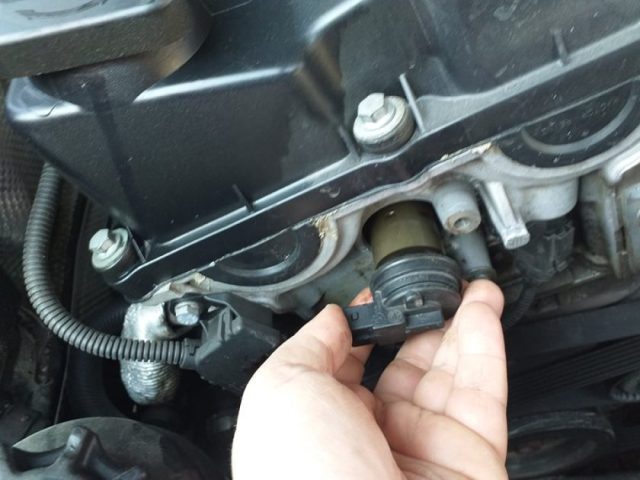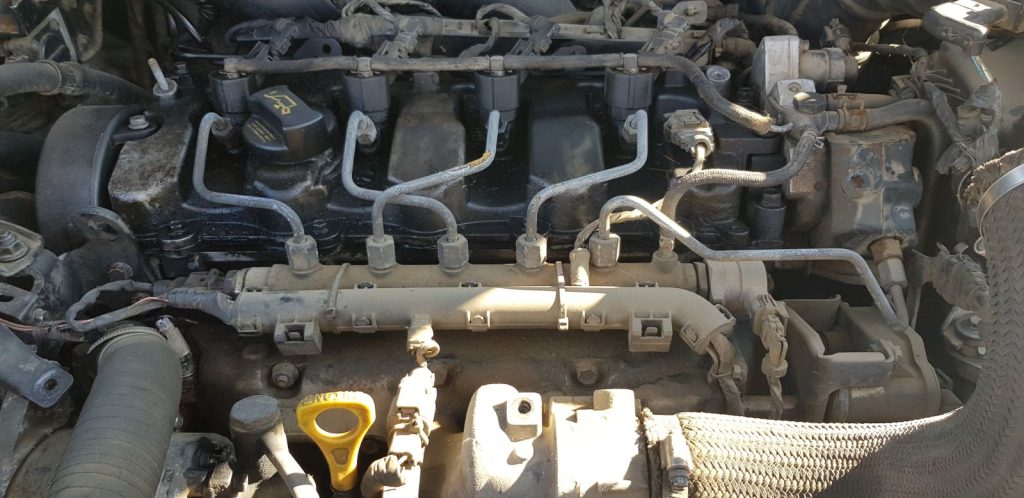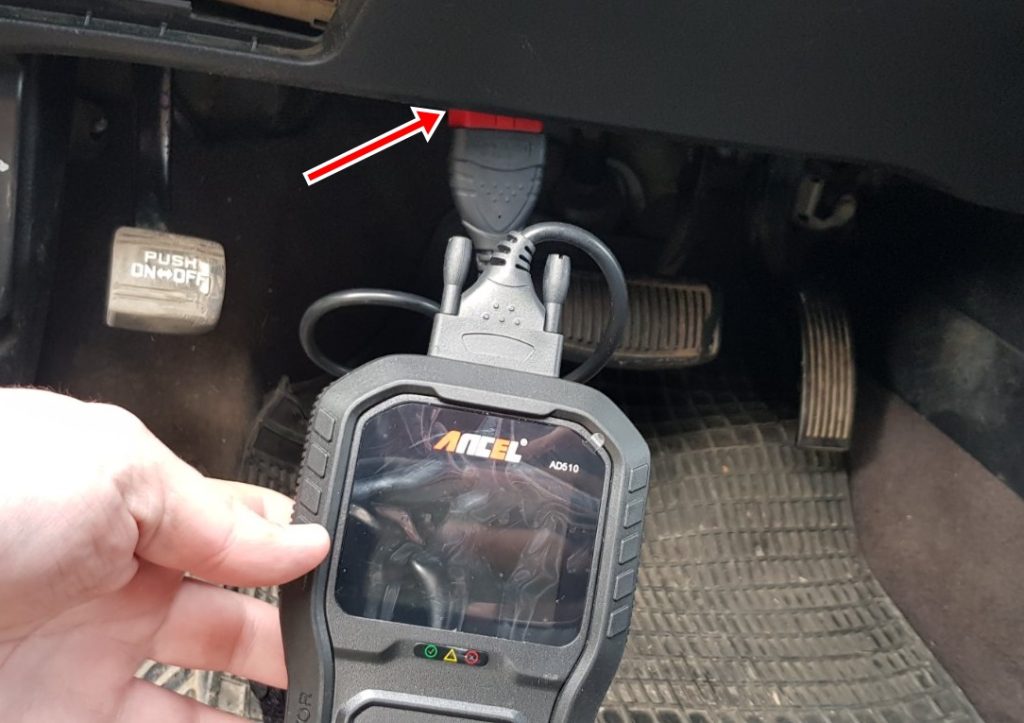If your vehicle uses variable valve timing (VVT), then you may have noticed oil leaking from the solenoid connector of your VVT controller.
This can be a serious issue that could lead to engine damage if left unfixed. In this blog post, we’ll look into the causes, symptoms, and solutions for oil in VVT solenoid connectors.
- Key Takeaway
- What Is a VVT Solenoid Connector and What Does It Do?
- Types of VVT Solenoid Connectors In Vehicles
- Why Is There Oil In The VVT Solenoid Connector?
- Symptoms Of Oil In VVT Solenoid Connector
- Why Is My VVT Solenoid Leaking Oil?
- Can a Car Run Without VVT Solenoid?
- How To Test a VVT Solenoid Connector
Key Takeaway
- The most common cause of oil in the VVT solenoid connector is a worn-out or damaged seal that allows oil to escape and leak out.
- Symptoms of oil in the VVT solenoid connector are ignited check engine light, rough idle, poor acceleration, reduced fuel economy, decreased engine performance, loss of power, and engine misfire.
What Is a VVT Solenoid Connector and What Does It Do?

A VVT(variable valve timing) solenoid connector is a small electrical connector that helps regulate oil flow in vehicles’ engines. Usually located near the front of the engine, this part consists of two pieces: a housing that attaches to the block, and a plunger fitting inside this housing.
The plunger of a VVT solenoid housing is connected to a rod that runs through its center. This rod connects to an oil pump inside the vehicle’s engine compartment. As oil pressure builds inside, it causes the plunger to move up and down in response.
This movement allows oil to pass through a small passage in the housing and into the engine’s valves. The VVT solenoid helps regulate the timing for these events, increasing fuel efficiency and performance at the same time.
Two ways to check the VVT solenoid connector are with a mechanic’s stethoscope or digital multimeter. Place the diaphragm of your stethoscope onto the oil port of the connector and listen for ticking noises; if none occurs, then oil pressure is not reaching the VVT solenoid.
To test the VVT solenoid connector with a digital multimeter, set it to resistance and place probes on its terminals. If resistance is between 5-10 ohms, oil pressure is not reaching the VVT solenoid. Checking this connection is an essential step in maintaining your car’s engine says Chevy Forum.
Why Is There Oil In The VVT Solenoid Connector?

Oil presence in the Variable Valve Timing (VVT) solenoid connector is typically due to a worn-out or damaged seal that allows oil to leak out.
Worn-out or Damaged Seal
The most common cause of oil in the VVT solenoid connector is a worn-out or defective seal. The seal’s primary function is to prevent oil from leaking out of the solenoid. However, over time and with constant use, this seal can wear down or become damaged, leading to oil leakage.
Oil Contamination
Another potential reason for the presence of oil in the VVT solenoid connector is oil contamination. The VVT solenoids operate based on engine oil pressure. Over time, if the oil becomes dirty or degraded, it can lead to various issues, including oil leakage into the solenoid connector.
Faulty VVT Solenoid
A faulty VVT solenoid could also be responsible for the oil presence in the connector. If the solenoid is damaged or malfunctioning, it may allow oil to escape and seep into the connector. This issue is not as common as the others but is still a possibility.
Leakage from Other Engine Parts
In some cases, oil may find its way into the VVT solenoid connector due to leaks from other parts of the engine. For example, a small oil leak next to the VCT solenoid could result in oil entering the electrical connector.
Manufacturing Defects
Although rare, manufacturing defects in the VVT solenoid or connector could lead to oil leakage. If the connector or solenoid isn’t properly designed or made, it might not seal correctly, allowing oil to leak out.
Types of VVT Solenoid Connectors In Vehicles
VVT Solenoid Connectors in vehicles are diverse components that connect the Variable Valve Timing solenoid to the vehicle’s electrical system, and their types largely vary based on the engine type and specific vehicle model.
Engine Variable Timing Solenoid Connector
This is a common type of VVT solenoid connector found in many vehicles. It plays a crucial role in facilitating the function of the VVT solenoid, enabling it to adjust the camshaft position using oil pressure. This type of connector is often available for purchase online and can be picked up at local auto parts stores.
Engine Coolant Temperature Sensor Connector
While not directly a VVT solenoid connector, the Engine Coolant Temperature Sensor Connector plays a significant role in the overall functioning of the engine, including the VVT system. It connects the engine coolant temperature sensor to the vehicle’s electrical system, which helps regulate the engine’s temperature and indirectly impacts the performance of the VVT solenoid.
ABS Wheel Speed Sensor Connector
Again, while not a direct VVT solenoid connector, the ABS Wheel Speed Sensor Connector contributes to the overall performance of the vehicle, including its engine’s function. Connecting the ABS wheel speed sensor to the car’s electrical system aids in regulating the anti-lock braking system, which can indirectly impact the efficiency of the VVT system.
Plug and Socket Electrical Connector Type
Some VVT solenoid connectors come in a plug-and-socket electrical connector type. This design facilitates easy connection and disconnection of the VVT solenoid from the vehicle’s electrical system.
Standard Ignition VVT Solenoid Connector
Standard Ignition VVT Solenoid Connectors are designed for both on and off-road use and all weather conditions. They connect the VVT solenoid to the vehicle’s electrical system, allowing the solenoid to control the camshaft position based on the engine’s speed and load.
ALLMOST Variable Valve Timing Solenoid Connector
This type of VVT solenoid connector is specifically designed for certain GM engines. The ALLMOST Variable Valve Timing Solenoid Connector is compatible with the 2.2L and 2.4L GM engine intake side camshaft, allowing the VVT system to function optimally.
Engine Variable Valve Timing (VVT) Solenoid Connector-Timing Solenoid Connector
This type of connector often found on eBay and other online marketplaces, caters to a specific range of engines, including 1.0L 999CC 61Cu. It plays a crucial role in connecting the timing solenoid to the vehicle’s electrical system, ensuring smooth and efficient engine performance.
Symptoms Of Oil In VVT Solenoid Connector
The variable valve timing (VVT) solenoid was designed to help with engine lubrication. The ECU sends information to the VVT solenoid connector when to engage and disengage, thus controlling oil flow.
Unfortunately, due to constant exposure to high temperatures, some gaskets on VVT solenoid connectors may fail, allowing oil into the connector.
Here are some common symptoms associated with oil in VVT solenoid connectors:
1. Check engine light

Oil in the VVT solenoid connector can lead to various engine performance issues, with one of the most prevalent symptoms being a check engine light. This light is activated by P0010, P0011, P0012, P0013, and P0014 trouble codes which can be read using an OBD2 scanner.
2. Rough idling

Rough idling is one of the signs that there may be oil in the VVT solenoid connector. This device regulates oil flow to engine valves, adjusting timing as necessary.
When this solenoid isn’t functioning properly due to oil in its connector, timing issues arise which could include rough idling, stalling, poor acceleration, and high fuel consumption.
3. Poor acceleration

Oil in the VVT solenoid connector can manifest in various ways, but one of the most prevalent symptoms is poor acceleration.
This occurs because the VVT solenoid controls oil flow to engine valves, and when it malfunctions, those valves do not open and close as expected – leading to ineffective breathing and loss of power.
Other symptoms such as engine misfires, reduced fuel economy, or increased emissions may also accompany poor acceleration.
4. Reduced fuel economy

As your car’s engine ages, internal components begin to experience more friction. One area that often suffers is the valves controlling oil flow: these often show signs of wear.
To help combat this problem, many engines come equipped with a Variable Valve Timing (VVT) system which utilizes oil pressure to adjust valve timing and optimize performance.
If the VVT solenoid becomes clogged or damaged, oil can seep into the connector and lead to various problems such as reduced fuel economy and engine vibration.
Furthermore, if you suspect your car’s VVT system may not be functioning optimally, have it checked by a certified mechanic immediately.
5. Decreased engine performance

If your engine has started to sound rough or you’ve noticed a decrease in performance, it could be an indication that it’s time to check your VVT solenoid connector. This device controls oil flow to valves within the engine; when it fails due to an oil leak, you will experience diminished performance.
You might hear an unusual noise coming from the engine, or notice your check engine light coming on. If any of these symptoms apply to you, it’s essential that the issue be diagnosed and fixed promptly; otherwise, serious damage could occur to your engine.
6. Loss of power

When your vehicle begins to experience power loss, it can be both frustrating and hazardous. There are many potential causes of this issue, but one that often goes overlooked is a damaged VVT solenoid connector.
This device controls oil flow to engine valves when instructed by its connector; if that oil supply is inadequate due to an oil leak, your engine won’t get the proper amount of oil and you may experience increased engine braking.
There are several telltale signs that your VVT solenoid may need replacing, including decreased fuel economy, diminished engine performance, and increased noise from the engine.
If you notice any of these symptoms in your vehicle, it’s essential to have it examined by a qualified mechanic right away; neglecting this problem could result in costly engine damage if left unrepaired.
7. Engine misfire

Variable Valve Timing (VVT) is an engine strategy used by manufacturers to enhance performance, fuel economy, and emissions.
This process utilizes a phaser and hydraulic control solenoid operated by the computer system to advance or retard intake and exhaust valve timing. This improves engine breathing thus producing more power while running more efficiently.
A VVT solenoid’s primary responsibility is to regulate oil flow and activate the phaser. If there’s an issue with its connector, it can oftentimes lead to the misfiring of the engine.
A sign of a failing or defective VVT solenoid is an illuminated check engine light. Other symptoms may include reduced fuel economy, strange noises coming from the engine, or even stalling.
Why Is My VVT Solenoid Leaking Oil?

Your car’s engine circulates oil through a series of channels and passages, lubricating various parts and providing cooling. An integral component in this system is the oil pump, which draws oil from a pan beneath it before sending it to various bearings throughout.
The oil then moves through the cylinder heads and into valves (including the variable valve timing solenoid), where it lubricates their moving parts. After draining back into an oil pan, this cycle begins again.
A VVT solenoid is responsible for controlling the oil flow in an engine and it’s typically located near the timing belt. If you notice oil leaking from your VVT solenoid, it could be due to a damaged seal or gasket. In some cases, replacing the entire solenoid may be necessary; however, if the leak is minor, replacing just the seal or gasket may suffice.
The seal on a VVT solenoid is designed to prevent oil from escaping. It sits between the body of the solenoid and plunger, which moves when powered up – so this prevents any oil from dripping past it. Once turned off, however, the plunger returns to its original position, keeping any remaining moisture out.
If the seal on your variable valve timing (VVT) solenoid is worn or damaged, the oil will escape and leak out. To replace it, take out the solenoid and install a new seal.
Can a Car Run Without VVT Solenoid?

Yes, a car can run without a VVT solenoid, but it won’t be running as efficiently as possible. Your car’s VVT solenoid controls oil flow to the engine and allows your engine to vary intake and exhaust valve timing for increased fuel economy and power production.
VVT solenoid technology allows engines to take advantage of certain advantages without it, though it could still run without optimal efficiency if removed. Ultimately, car owners have the final say as to whether or not they wish to remove this component.
How To Test a VVT Solenoid Connector
The VVT solenoid connector is an essential element of your car’s engine, helping to control oil flow. However, over time this important part may start malfunctioning and cause you to experience issues with your vehicle.
Here’s how to test a VVT solenoid connector:
1. Scan the vehicle for trouble codes

Before working on your VVT solenoid connector, first scan for trouble codes in your vehicle. To do this, connect an OBD2 scanner to the main computer port under the steering wheel. Press run to see which errors your car has.
If there’s an issue with the VVT solenoid connector, codes such as P0010, P0011, P0012, P0013, and P0014 may appear. This indicates that some part of the system may be malfunctioning and you should start by testing the connector for possible causes.
2. Locate the VVT solenoid connector

To locate the VVT solenoid connector, you need to open the hood. Make sure the engine is cold and then look around for an oil pump.
In most cases, you should find this VVT on one side of the engine connected to its oil pump. In most cases, it will be secured with one bolt and wires/connectors on top.
3. Unplug the connector

The connector responsible for engaging and disengaging the VVT solenoid is a snap-on type. To remove it, press down on the plastic (not the wires) then slowly pull.
If you have never disconnected this connector before, it may be difficult at first. Just go slowly so as not to damage any wiring.
4. Test the connector with a multimeter

Place the key into the ignition and turn it to “ON,” but do not start your vehicle yet. Just enough electricity needs to run through its system.
Set your multimeter for DC volts readings, and insert test leads into both electrical connectors (one in each hole). If the VVT solenoid connector is damaged or defective, you won’t get a reading – no flow of electricity through this connector and into the VVT solenoid will occur.
FAQs
What causes oil in VVT solenoid connector?
Oil presence in the Variable Valve Timing (VVT) solenoid connector is typically due to a worn-out or damaged seal that allows oil to leak out. Other potential reasons include oil contamination, a faulty VVT solenoid, leakage from other engine parts, or manufacturing defects.
Is oil in the VVT solenoid connector a common issue?
Yes, it is a fairly common issue. Due to regular use and exposure to high temperatures within the engine, the seals of the VVT solenoid can wear down over time and allow oil to leak into the connector.
How does oil get into the electrical connector of the VVT solenoid?
The VVT solenoids operate based on engine oil pressure. If the oil becomes dirty or degraded, it can lead to various issues, including oil leakage into the solenoid connector. Additionally, if the seal preventing oil leakage gets worn out or damaged, oil may seep into the connector.
What are the symptoms of oil in the VVT solenoid connector?
Symptoms can include a decrease in fuel efficiency, a lack of power when accelerating, rough idling, and engine misfires. In some cases, the check engine light might also come on.
Can I drive my vehicle if there’s oil in the VVT solenoid connector?
It’s not recommended to drive your vehicle with this issue as it can lead to more severe engine problems. It’s best to get the issue fixed as soon as possible.
How do I fix oil in the VVT solenoid connector?
Fixing this issue usually involves replacing the faulty seal or the entire VVT solenoid if it’s defective. It’s advisable to have an experienced mechanic handle this repair as it can be complex and requires specific tools.
Can regular oil changes prevent oil in the VVT solenoid connector?
Regular oil changes can help keep the oil clean, reducing the chances of oil contamination. They might not prevent oil from leaking into the VVT solenoid connector if the seal is damaged or worn out. Regular maintenance checks can help detect and fix such issues early on.
Conclusion and final thoughts
The VVT solenoid connector plays a crucial role in the proper functioning of engines that use variable valve timing technology.
Its primary function is to regulate the flow of oil through the engine’s components, ensuring optimal performance and efficiency.
